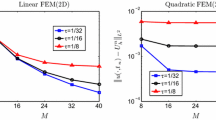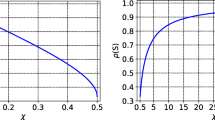Abstract
The paper is concerned with the unconditional stability and optimal \(L^2\) error estimates of linearized Crank–Nicolson Galerkin FEMs for a nonlinear Schrödinger–Helmholtz system in \({\mathbb {R}}^d\) (\(d=2,3\)). By introducing a corresponding time-discrete system, we separate the error into two parts, i.e., the temporal error and the spatial error. Since the latter is \(\tau \)-independent, the uniform boundedness of numerical solutions in \(L^{\infty }\)-norm follows an inverse inequality immediately without any restrictions on time stepsize. Then, optimal error estimates are obtained in a routine way. Numerical examples in both two and three dimensional spaces are given to illustrate our theoretical results.



Similar content being viewed by others
References
Antoine, X., Besse, C., Klein, P.: Absorbing boundary conditions for general nonlinear Schrödinger equations. SIAM J. Sci. Comput. 33, 1008–1033 (2011)
Akrivis, G.D., Dougalis, V.A., Karakashian, O.A.: On fully discrete Galerkin methods of second-order temporal accuracy for the nonlinear Schrödinger equation. Numer. Math. 59, 31–53 (1991)
Bao, W., Cai, Y.: Uniform error estimates of finite difference methods for the nonlinear Schrödinger equation with wave operator. SIAM J. Numer. Anal. 50, 492–521 (2012)
Bao, W., Mauser, N.J., Stimming, H.P.: Effective one particle quantum dynamics of electrons: a numerical study of the Schrödinger–Poisson-X$\alpha $ model. Commun. Math. Sci. 1, 809–828 (2003)
Berezin, F.A., Shubin, M.A.: The Schrödinger Equation. Kluwer Academic Publishers, Dordrecht (1991)
Bohun, S., Illner, R., Lange, H., Zweifel, P.F.: Error estimates for Galerkin approximations to the periodic Schrödinger–Poisson system, ZAMM$\cdot $Z. Angew. Math. Mech. 76, 7–13 (1996)
Borz, A., Decker, E.: Analysis of a leap-frog pseudospectral scheme for the Schrödinger equation. J. Comput. Appl. Math. 193, 65–88 (2006)
Bratsos, A.G.: A modified numerical scheme for the cubic Schrödinger equation. Numer. Methods Part Differ. Equ. 27, 608–620 (2011)
Cannon, J.R., Lin, Y.: Nonclassical $H^1$ projection and Galerkin methods for nonlinear parabolic integro-differential equations. Calcolo 25, 187–201 (1988)
Cao, Y., Musslimani, Z.H., Titi, E.S.: Nonlinear Schrödinger–Helmholtz equation as numercal regularization of the nonlinear Schrödinger equation. Nonlinearity 21, 879–898 (2008)
Chang, Q., Jia, E., Sun, W.: Difference schemes for solving the generalized nonlinear Schrödinger equation. J. Comput. Phys. 148, 397–415 (1999)
Chen, Z., Hoffmann, K.-H.: Numerical studies of a non-stationary Ginzburg–Landau model for superconductivity. Adv. Math. Sci. Appl. 5, 363–389 (1995)
Dehghan, M., Taleei, A.: Numerical solution of nonlinear Schrödinger equation by using time-space pseudo-spectral method. Numer. Methods Part Differ. Equ. 26, 979–990 (2010)
Douglas Jr., J., Ewing, R.E., Wheeler, M.F.: A time-discretization procedure for a mixed finite element approximation of miscible displacement in porous media. RAIRO Anal. Numer. 17, 249–265 (1983)
Dupont, T., Fairweather, G., Johnson, J.P.: Three-level Galerkin methods for parabolic equations. SIAM J. Numer. Anal. 11, 392–410 (1974)
Harrison, R., Moroz, I., Tod, K.P.: A numerical study of the Schrödinger–Newton equations. Nonlinearity 16, 101–122 (2003)
He, Y.: The Euler implicit/explicit scheme for the 2D time-dependent Navier–Stokes equations with smooth or non-smooth initial data. Math. Comput. 77, 2097–2124 (2008)
Hou, Y., Li, B., Sun, W.: Error analysis of splitting Galerkin methods for heat and sweat transport in textile materials. SIAM J. Numer. Anal. 51, 88–111 (2013)
Jin, J., Wu, X.: Analysis of finite element method for one-dimensional time-dependent Schrödinger equation on unbounded domain. J. Comput. Appl. Math. 220, 240–256 (2008)
Leo, M.D., Rial, D.: Well posedness and smoothing effect of Schrödinger–Poisson equation. J. Math. Phys. 48, 093509 (2007)
Li, B.: Mathematical modeling, analysis and computation for some complex and nonlinear flow problems, Ph.D. thesis, City University of Hong Kong, Hong Kong (2012)
Li, B., Sun, W.: Error analysis of linearized semi-implicit Galerkin finite element methods for nonlinear parabolic equations. Int. J. Numer. Anal. Model. 10, 622–633 (2013)
Li, B., Sun, W.: Unconditional convergence and optimal error estimates of a Galerkin-mixed FEM for incompressible miscible flow in porous media. SIAM J. Numer. Anal. 51, 1959–1977 (2013)
Li, B.K., Fairweather, G., Bialecki, B.: Discrete-time orthogonal spline collocation methods for Schrödinger equations in two space variables. SIAM J. Numer. Anal. 35, 453–477 (1998)
Liao, H., Sun, Z., Shi, H.: Error estimate of fourth-order compact scheme for linear Schrödinger equations. SIAM J. Numer Anal. 47, 4381–4401 (2010)
López-Marcos, J.C., Sanz-Serna, J.M.: A definition of stability for nonlinear problems. In: Numerical Treatment of Differential Equations. Teubner-Texte zur Mathematik, Band 104, Leipzig, pp. 216–226 (1988)
Lu, T., Cai, W.: A Fourier spectral-discontinuous Galerkin method for time-dependent 3-D Schrödinger–Poisson equations with discontinuous potentials. J. Comput. Appl. Math. 220, 588–614 (2008)
Lubich, C.: On splitting methods for Schrödinger–Poisson and cubic nonlinear Schrödinger equations. Math. Comput. 77, 2141–2153 (2008)
Masaki, S.: Energy solution to a Schrödinger–Poisson system in the two-dimensional whole space. SIAM J. Math. Anal. 43, 2719–2731 (2011)
Mu, M., Huang, Y.: An alternating Crank–Nicolson method for decoupling the Ginzburg–Landau equations. SIAM J. Numer. Anal. 35, 1740–1761 (1998)
Pathria, D.: Exact solutions for a generalized nonlinear Schrödinger equation. Phys. Scr. 39, 673–679 (1989)
Pelinovsky, D.E., Afanasjev, V.V., Kivshar, Y.S.: Nonlinear theory of oscillating, decaying, and collapsing solitons in the generalized nonlinear Schrödinger equation. Phys. Rev. E 53, 1940–1953 (1996)
Reichel, B., Leble, S.: On convergence and stability of a numerical scheme of coupled nonlinear Schrödinger equations. Comput. Math. Appl. 55, 745–759 (2008)
Sanz-Serna, J.M.: Methods for the numerical solution of nonlinear Schrödinger equation. Math. Comput. 43, 21–27 (1984)
Schürmann, H.W.: Traveling-wave solutions of the cubic-quintic nonlinear Schrödinger equation. Phys. Rev. E 54, 4312–4320 (1996)
Stimming, H.P.: The IVP for the Schrödinger–Poisson-X$\alpha $ equation in one dimension. Math. Models Methods Appl. Sci. 8, 1169–1180 (2005)
Sulem, C., Sulem, P.L.: The Nonlinear Schrödinger Equation: Self-Focusing and Wave Collapse. Springer, New York (1999)
Sun, W., Wang, J.: Optimal error analysis of Crank–Nicolson schemes for a coupled nonlinear Schrödinger system in 3D. J. Comput. Appl. Math. 317, 685–699 (2017)
Sun, Z., Zhao, D.: On the $L_{\infty }$ convergence of a difference scheme for coupled nonlinear Schrödinger equations. Comput. Math. Appl. 59, 3286–3300 (2010)
Temam, R.: Naiver–Stokes Equations: Theory and Numerical Analysis. North-Holland Publishing Company, Amsterdam (1979)
Thomée, V.: Galerkin Finite Element Methods for Parabolic Problems. Springer, Berlin (1997)
Tourigny, Y.: Optimal $H^1$ estimates for two time-discrete Galerkin approximations of a nonlinear Schrödinger equation. IMA J. Numer. Anal. 11, 509–523 (1991)
Wang, T., Guo, B., Zhang, L.: New conservative difference schemes for a coupled nonlinear Schrödinger system. Appl. Math. Comput. 217, 1604–1619 (2010)
Wu, H., Ma, H., Li, H.: Optimal error estimates of the Chebyshev–Legendre spectral method for solving the generalized Burgers equation. SIAM J. Numer. Anal. 41, 659–672 (2003)
Zhang, Y., Dong, X.: On the computation of ground state and dynamics of Schrödinger–Poisson–Slater system. J. Comput. Phys. 220, 2660–2676 (2011)
Zlámal, M.: Curved elements in the finite element method. $\text{ I }^*$. SIAM J. Numer. Anal. 10, 229–240 (1973)
Zouraris, G.E.: On the convergence of a linear two-step finite element method for the nonlinear Schrödinger equation. M2AN Math. Model. Numer. Anal. 35, 389–405 (2001)
Acknowledgements
The author would like to thank Professor Weiwei Sun for the valuable discussions. The author would also like to thank the anonymous referees for their suggestions and comments, which helped to improve the quality of the paper.
Author information
Authors and Affiliations
Corresponding author
Additional information
The work of the author was supported in part by the USA National Science Foundation Grant DMS-1315259, the USA Air Force Office of Scientific Research Grant FA9550-15-1-0001, and a grant from the Research Grants Council of the Hong Kong Special Administrative Region, China (Project No. CityU 11300517).
Rights and permissions
About this article
Cite this article
Wang, J. Unconditional stability and convergence of Crank–Nicolson Galerkin FEMs for a nonlinear Schrödinger–Helmholtz system. Numer. Math. 139, 479–503 (2018). https://doi.org/10.1007/s00211-017-0944-0
Received:
Revised:
Published:
Issue Date:
DOI: https://doi.org/10.1007/s00211-017-0944-0
Keywords
- Unconditionally optimal error estimates
- Linearized Crank–Nicolson Galerkin FEMs
- Nonlinear Schrödinger–Helmhotz equations




